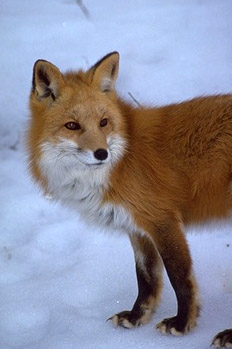
THE SIERRA NEVADA RED FOX
Also known as High Sierra Red Fox, is small-sized canid, with long and slender legs and
pointed muzzle, and long brush-like tail. A montane, small-sized subspecies of North American
Red Fox, with a relatively short tail. Pelage is dark dull rusty fulvous, resembling that of fulvus,
becoming much paler on sides, where the whitish underfur shows through. Externally is similar to Vulpes fulva fulva; it has a short tail, but cranially it is more like Vulpes fulva macroura.
Throat and chest are
white. Face dull fulvous, strongly grizzled with whitish. Sides of nose dusky, darker than in fulvus,
grizzled with buffy. Cross and silver color phases are very common in this subspecies. Black of
legs much restricted. Tail is relatively small, differing widely from the big tail of macrourus, fulvous
in color at base, becoming buffy whitish and profusely mixed with long black hairs, base with a
black spot, and white tip. White-tipped tails are common to all color phases.
It is likely one of the most endangered mammals in North America. The High Sierra fox shares most of its physical characteristics with the red fox, though it is slightly smaller and has some special adaptions for travel over snow. The High Sierra fox was discovered as a subspecies in 1937, but its study lapsed for more than half a century before its populations were rediscovered beginning in 1993. This subspecies of red fox may live up to 6 years.
Reproduction and behavior
- Gestation: 51-53 days.
- Young per birth: 2-3.
- Weaning: 56-70 days.
- Sexual maturity: 12 months.
- Life span: 5-6 years.
- Breeding season: Between December and March.
Similar to lowland-dwelling North American Red Fox subspecies, births occur from March through May in sheltered dens. Social behavior: Mated pairs and monogamous, reproductive output is generally low in montane foxes.
Diet and interaction with the environment
The Sierra Nevada Red Foxes are opportunistic predators and foragers, with a diet primarily
composed of small rodents, but also including deer carrion, particularly
in winter and spring, and manzanita berries, particularly in fall. Main
predators: Golden eagle.
Most active at dusk and at night when many
rodents are most active. This montane subspecies is characterized
by specialized adaptations to cold areas, including a particularly thick
and deep winter coat, small toe pads that are completely covered
in winter by dense fur to facilitate movement over snow, a smaller
size that may also facilitate movement over snow by lowering weight
supported per square centimeter of foot pad. Its smaller size may also
be due to reduced abundance of prey at higher elevations. In Lassen,
home ranges range from 0.03 to 6.9 km2
in summer, larger in winter. At
Sonora Pass home ranges average 9.1 km2.
Habitat:
Native to United States, only two populations persist
today; one near Lassen Volcanic National Park, and a second near
Yosemite National Park and Sonora Pass. Some authors include
Red Foxes of the Oregon Cascades in this subspecies. Subspecific
status of Foxes in Nevada is unknown.
Their habitat consists in multiple habitat types in the alpine and subalpine zones (near and above tree line), meadows and rocky areas.
Conservation status: Critically Imperiled. Regional
status: Critically endangered, and possibly declining, with an estimated
population likely less than 50. Main threats include small population size
and isolation, hybridization with non-native Red Fox, climate change,
and competition and predation from coyotes. It is protected from
hunting and trapping by California fish and game laws. It does not enjoy
any elevated conservation status in the states of Oregon or Nevada.

Physiognomic information:
- Body length: 67.5 cm (♂), 61.3 cm (♀)
- Tail length: 35-38 cm
- Height: 35-40 cm
- Weight: 4-4.2 kg (♂), 3.3-3.5 kg (♀)
- Skull: 15 cm
Taxonomy:
The North American red foxes have been traditionally considered either as subspecies of the Old World red foxes, Vulpes vulpes, or subspecies of their own species, Vulpes fulva. Due to the opinion that North American red foxes were introduced from Europe, all North American red foxes have been seen as conspecific with Vulpes vulpes; however, genetic analyses of global red fox haplotypes indicates that the North American red foxes have been genetically isolated from the Old World populations for 400,000 years, prompting possible application of Vulpes fulva to all North American red foxes.
At least 9 subspecies are generally recognized in North America (Aubry, 1983 and 2009, Kamler and Ballard, 2002; Sacks, 2010): Vulpes fulva fulva (Eastern United States),
Vulpes fulva rubricosa (central and E Canada),
Vulpes fulva regalis,
Vulpes fulva alascensis (boreal Alaska),
Vulpes fulva abietorum (boreal Canada),
Vulpes fulva macroura (Rocky Mountains),
Vulpes fulva cascadensis (Cascade Range),
Vulpes fulva necator (Sierra Nevada) and
Vulpes fulva patwin (Sacramento Valley).
Castello (2018) has formalized treatment of Vulpes fulva as a separate species from the Old World Vulpes vulpes. In 2014, Mark J. Statham among others released a study that supports Vulpes fulva as a separate species from the Old World Vulpes vulpes. More about the Vulpes vulpes fulva and Vulpes fulva discussion:
Gallery:
Due to the similarity in appearance between North American Red Foxes, some of the images may be erroneous. That's why I haven't found any videos about this subspecies either, if you think you have any image or video of the Vulpes fulva necator let me know in the comments or contact me on any of my social networks (@etzharai).


















No hay comentarios:
Publicar un comentario